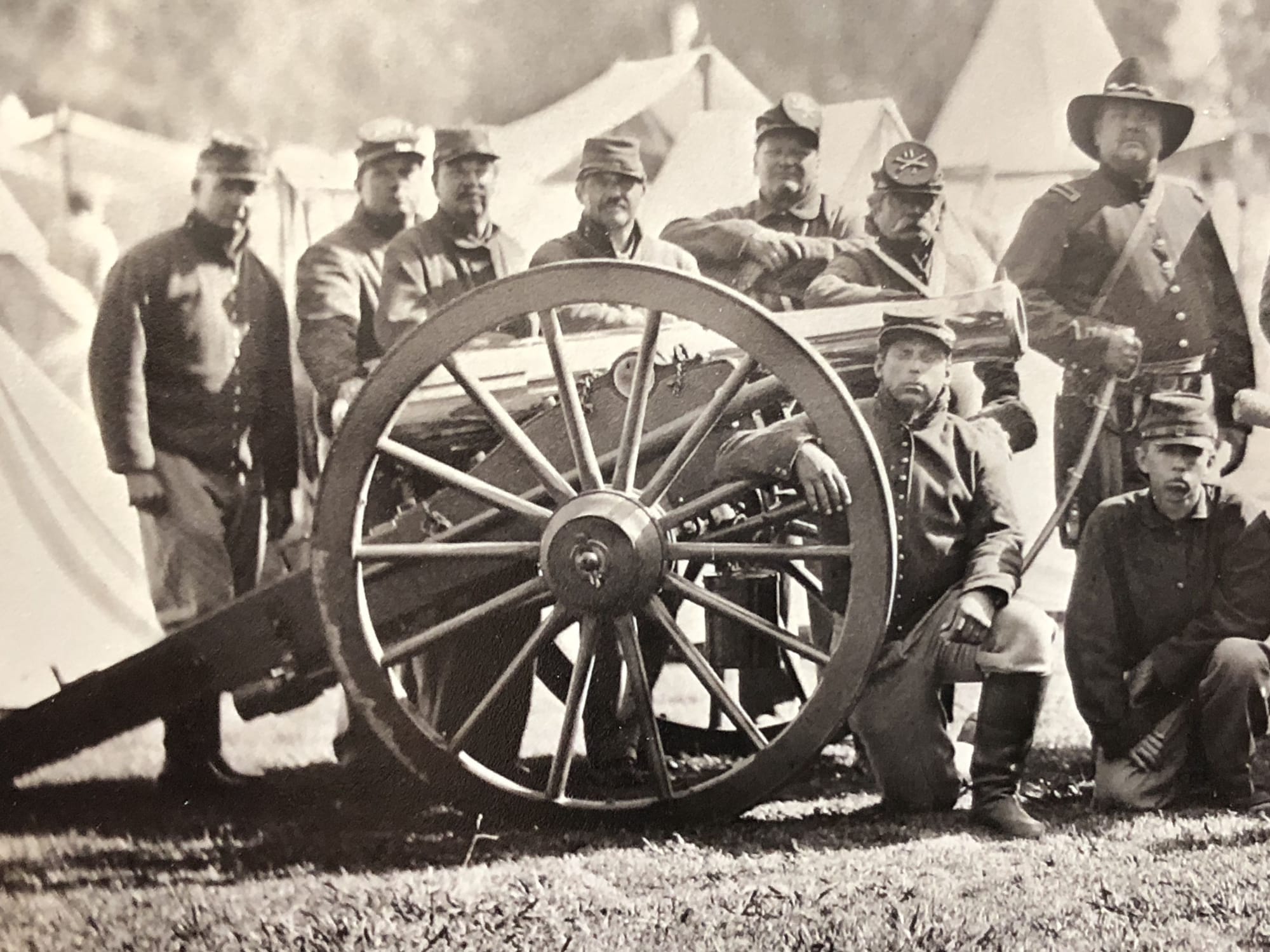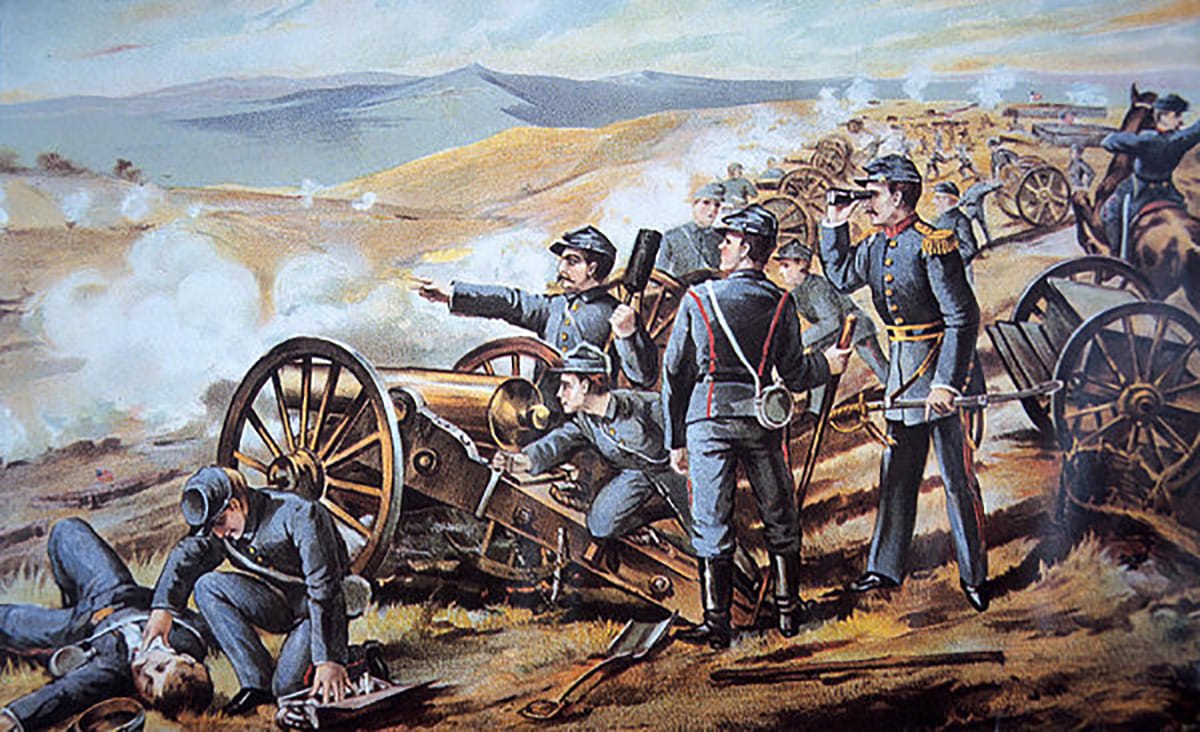A Brief History of Artillery
Long before the roar of modern tanks echoed on battlefields, the canister round had its day in the sun. Picture this: it's 1410, and artillery crews are looking for a way to keep the enemy at bay — enter the canister round, a clever early solution for those perilous close encounters.
Now, let’s shuffle the deck of history a bit. As the 20th and 21st centuries rolled in, tanks emerged as the new behemoths of warfare, yet they reached back through time to borrow the canister's devastating punch for their own arsenal. It's a classic case of an old dog teaching new tricks, where these rounds found new life in the hands of modern militaries on distant shores.
But how did we get from there to here? The journey takes us through gritty battlefields like the Napoleonic Wars and the American Civil War, where the canister round had its heyday. During these conflicts, artillery wasn't just supporting the troops; it was a headline act, thanks to the marriage of innovation and improved manufacturing. With a boosted range and a nasty bite, upgraded canister shells could shatter an advancing line of infantry like glass.
In this dance of destruction, the canister round has been a constant partner, evolving yet enduring, a testament to the timelessness of military ingenuity.
Napoleonic Artillery

The dawning of the 19th century brought with it the rise of Napoleon Bonaparte, the face of warfare, particularly the artillery that roared across the battlefields, was undergoing a revolution of its own. The cannons that once were as cumbersome as the age-old Turkish bombards, now, through the advancements in metallurgy, were transformed. These new artillery pieces, like the Napoleonic 12-pounders, had shed the excess weight of their predecessors without sacrificing strength, rendering them as agile as rowboats when juxtaposed with the cumbersome destroyers of their time.
The leap in technology didn't end at mere weight and size. The art of warfare was refined with enhancements in the accuracy of sights and the advent of firing tables. These innovations empowered the artillery commanders with the ability to swiftly calculate the perfect trajectory and select the optimal munition for their deadly craft. It was this synergy of reduced weight, increased accuracy, and rapid-fire capability that enabled these cannons to unleash destruction upon the enemy with a precision and ferocity that had hitherto been unknown.
In this era of unceasing innovation, the cannon's power transcended mere displays of might, evolving into a precise tool of warfare. Its efficiency left an indelible mark on military history, shaping the course of Napoleon's campaigns.
Imagine a battlefield where might was measured in weight, and the Ottomans were the undisputed champions. They crafted bombards, the titans of artillery, which could command the field with just seven thunderous shots a day. These war machines weren't just heavy; they were colossal, each weighing as much as 19 tons. That's the kind of weight that would make even a modern crane creak.
But such might came with a catch: mobility was a fantasy when it required 60 oxen and a small army of 200 men to coax these giants into position. Albert Manucy, a historian in 1949, noted this herculean effort, highlighting the impracticality of these cast-bronze leviathans. They were as difficult to move as mountains and nearly as slow to fire.
As warfare raced forward, leaving behind the slower, more ponderous days of the 14th century, these bombards — for all their fearsome power — became relics, reminders of a time when wars were measured in weight lifted rather than swift strikes. Their legacy is a testament to the ingenuity of the past, and yet a clear signpost of how far the art of war has traveled. Now, they stand as monuments to the changing tides of battle, where once they were the queens of the battlefield, they now rest as the rooks, solid but overtaken by the quick and cunning weapons of modern warfare.
Picture the battlefield as a grand theater, where artillery batteries were the maestros orchestrating destruction with a diverse repertoire. Among the oldest of their arsenal was the round-shot, a hefty sphere of cast iron that when launched, knew only the language of blunt force. Then came its more cunning sibling, the fused shell, filled with black powder, ready to burst mid-air and shower shrapnel down upon the enemy, or to erupt upon impact, creating havoc in its wake.
Amidst these choices, the canister shot held a special place in the annals of warfare. A canister was like the grand finale of an orchestra's performance, reserved for moments of sheer intensity when the enemy dared too close. Within its metal casing were twenty-seven 1.5-inch iron balls that, upon firing, splayed outwards in a deadly bloom, much like the petals of a flower designed by Mars, the god of war.
In an era where artillerymen might have chosen to lay siege from a distance, Napoleon rewrote the script. He saw the canister not as a tool of defense but as an instrument of aggressive strategy. He pushed his gunners forward, right to the edge of musket range, to unleash the canister's wrath. The result was a maelstrom of metal that could tear through ranks of infantry, creating gaps for his soldiers and horsemen to deliver the coup de grâce.
This artful use of canister shells by Napoleon was not just about inflicting casualties; it was a psychological stroke of genius. The mere sound of the canister's discharge and the ensuing chaos it wrought could unravel the tightest military formations, setting the stage for victory even before the final act was played out.
What about it's effectiveness?
In the dance of war, the stage was set at Friedland in 1807, a place we now know as Kaliningrad, where a masterclass of military strategy was about to unfold. Napoleon's Grande Armée, a force that marched with the thunder of destiny, found their Russian adversaries precariously exposed. General Senarmont, a conductor of cannons, saw the perfect moment to close the curtains on the Russian resistance.
With a cold precision that belied the chaos of battle, Senarmont orchestrated a deadly advance, positioning two batteries — a dozen cannons strong — a mere 150 yards from the Russian lines. Here, the geography itself conspired with the French, as the land pinched in, setting the stage for a concentrated crescendo of firepower.
And then, with the Russians in the crosshairs of fate, the canister rounds sang their brutal aria. At such a range, these instruments of iron and fire shattered the air and earth alike. As noted by Kiley in his 2004 account, the canister rounds tore through the Russian ranks with a ferocity that etched the engagement into the annals of military lore. It was here that the canister rounds, those harbingers of destruction, proved their worth in a symphony of devastation, choreographed by Napoleon, and executed with chilling efficiency by his artillerymen.
The curtain call of the Battle of Friedland was a dramatic climax worthy of a grand opera. The French artillery and infantry, in a magnificent duet under the baton of Marshal Ney and General Dupont, orchestrated a retreat that sent the Russian soldiers reeling back, pressed against the Alle River's unforgiving edge.
Friedland transformed, in those moments, from a mere town into a choke point of destiny. The Russians, in their desperate bid for escape, found only the jaws of a deadly trap, as their paths were cut off, the town itself becoming an anvil on which the French forces would hammer them relentlessly.
It was within these narrow streets that Senarmont's cannons, thirsty for the final act, roared to life. The Corps artillery, a force of about 50 cannons, unleashed a tempest of iron — 2,600 roundshot joined by 400 canister rounds. The air was thick with the song of metal, a requiem for the Russian retreat, as the French artillery swept through the streets, the river, and the very hopes of their foe. In a mere half-hour, history was written in gunpowder and blood, a testament to the brutal efficiency of Napoleonic warfare.
The Shells Used in the American Civil War

Leaping ahead over half a century from the dust of Friedland, the specter of battle tactics during the American Civil War strikes an eerily similar chord. A casual observer, transported from Napoleonic fields to the American fray, would find a familiar scene: regiments of men, stretched out in long lines, advancing like a human tide towards the enemy, seemingly undeterred by the hailstorm of artillery that awaited them.
Yet, even in the shadow of cannons' relentless roar, innovation crept into the martial ranks. The infantry, once packed tightly enough to make any sardine claustrophobic, now marched with a breath of space between each line, a whole thirty-two inches to be precise. It was a modest nod to survival, an attempt to thin the harvest reaped by artillery's grim scythe that had sliced through the ranks at Friedland.
But for all their spacing and strategy, the infantry still found themselves in the merciless embrace of artillery fire. Only the men at the front could retaliate, while their brothers behind remained fodder for the cannons' unyielding appetite. And among these engines of war, the 12-pound Napoleon cannon stood proud, its name uttered with the same respect by both the Blue and the Grey. At Gettysburg, these cannons were as numerous as stars in a twilight sky, with 142 of their kind ready to unleash fury upon the field.
As the war churned through seasons, the cannons proved their might time and again. In the Atlanta campaign's heat, a mere twenty-nine 12-pounder cannons held the line against a sea of up to 12,000 Confederate soldiers, a testament to the enduring power of spherical and canister rounds to shape the fate of thousands.
The true horror of these engagements was captured in the vivid nightmares recounted by Confederate General George W. Gordon. Amidst the Battle of Franklin, as his men charged with the weight of desperation, they were greeted not by victory but by a storm of lead and iron. The air itself was a cacophony of death's chorus: the cannons' roar, shells' piercing cries, muskets' staccato rhythm, and the bullets' relentless hiss. It was here that men fell not just to the reality of war but to its sheer, raw terror—a tableau of horror and majesty intertwined in memory and history.
Buckshot Shells of The Second World War
In the relentless advance of World War II, the art of war welcomed a grim ensemble of innovations, each more deadly than the last. Among these was the "Buckshot" like shell, a modern twist on the ancient canister concept, tailored for the steel behemoths that now roamed the battlefield: tanks.
In the unforgiving theatre of war in the Pacific during World War II, the US Marines faced the desperate bravery of Japanese infantry head-on. To counter these ferocious assaults, they turned to a new iteration of ammunition: the High-Explosive Fragmentation, or HE-Frag, shells. Crafted with a streamlined and functional design, these shells were built to withstand the rigors of battle. Their elongated bodies, often made of steel, minimized air resistance during flight. At the tip, a carefully calibrated fuze allowed Marines to choose between triggering the explosion upon impact with the enemy or at a predetermined distance. Markings on the shell's body conveyed essential information, from caliber to manufacturing details. In some cases, tail fins or stabilizers enhanced flight stability, a crucial feature for accuracy. These standardized HE-Frag shells played a pivotal role, delivering powerful explosions and deadly fragments, countering the fierceness of Japanese infantry in the harsh Pacific theatre of war.
On Bougainville, a stone's throw from the Australian coast, a game of martial cat-and-mouse played out with Sherman tanks cast in the role of devious bait. As Japanese soldiers surged forth in their harrowing charges, aiming to bring down these metal Goliaths with sheer force of will and explosives, a stealthy guardian lay in wait. At the critical moment, the light tanks, hidden from view, would unleash the Buckshot. A storm of thumbnail-sized projectiles would rain down, devastating the attackers with surgical precision, yet leaving the baited Sherman unscathed.
It was a tactic borne of necessity, a brutal chess move in the Pacific's sprawling game, where the stakes were as high as they were merciless.
Modernization of an Ancient Weapon
As the dust settled on the battlefields of history, the relentless evolution of military tactics and weaponry marched on. The records of war, once marked by the clashing of swords and the thundering volleys of cannon fire, now tell a story of a new era—an era dominated by machines of metal and might. It's a narrative of progress painted in the somber tones of necessity and survival, where the ingenuity of yesteryear's canister rounds finds its lineage continued in the modern munitions of today's armed forces.
Fast forward to the era of digital warfare and precision-guided conflict, where the grim art of war meets the cutting edge of technology. Here, in this high-tech arena, the canister round has been reborn, not as a simple cylinder filled with musket balls, but as a refined instrument of destruction tailored for the tanks that now roam the battlegrounds. It is within this context that we zoom into a specific page of military operations in the early 21st century.
In the modern era of armored warfare, the 120mm M1028 canister ammunition stands as a formidable weapon in the arsenal of tanks like the M1 Abrams, boasting a distinctive appearance. Encased in a sturdy, cylindrical metal cartridge, this 120mm round contains a projectile resembling a sizable, segmented can. As it hurtles through the air, the segmented outer surface shatters upon firing, releasing a lethal hail of smaller projectiles. Some iterations of this round incorporate stabilizing fins at the rear, enhancing accuracy during flight. The base of the projectile connects it to the cartridge case, housing the propellant responsible for launching this devastating anti-personnel round. This contemporary canister round, armed with a swarm of tungsten balls designed to disperse mid-flight, represents a stark demonstration of how the principles of the past have been honed to a deadly precision in the crucible of modernity. In October 2006, beneath the uneasy skies of Diwaniyah, Iraq, American M1A2 Abrams tanks, renowned for their prowess in modern warfare, were engaged in a fierce urban confrontation. As the conflict intensified, these cutting-edge armored behemoths turned to the M1028 canister round—a direct descendant of its primitive predecessors, yet vastly more lethal. This high-tech canister round, armed with a swarm of tungsten balls designed to disperse mid-flight, underscored how the lessons of history had been sharpened on the whetstone of modernity.
Amidst the chaos, one tank—identified as D24—found itself in the crosshairs of a rocket-propelled grenade. The response from D24's crew was swift and decisive, culminating in the deployment of the M1028, which met the oncoming threat with a wall of metal, ensuring the tank's place in the theater of war as both shield and sword.
This engagement in Diwaniyah is but a single thread in the vast tapestry of modern warfare, a testament to the enduring legacy of the canister round and a somber reflection of war's unchanging face. With each pull of the trigger, history whispers a question that echoes into the future: As the machinery of war becomes ever more sophisticated and deadly, what new chapters will be written in the narrative of human conflict?
